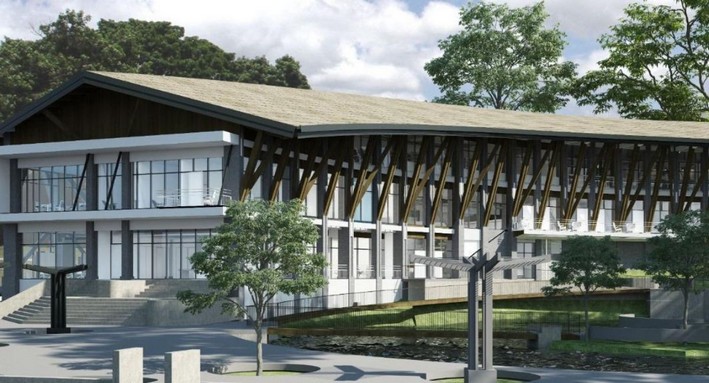When Trees Heal: From Thermalism to "Forest Bathing"
By María José Correa Gómez, PhD in History from University College London. Academic and researcher at the Department of Humanities (UNAB) and Director of the PhD in Applied Humanities (UNAB)
In the search for new forms of well-being, so-called "forest bathing" or "nature bathing" has gained prominence, presenting itself as a therapeutic novelty of Japanese origin—"Shinrin-yoku"—that highlights the healing potential of trees and their surroundings. This has led to the development of various projects, such as the recently inaugurated "forest baths" at the San Joaquín Campus or the practical Shinrin-yoku guide published some time ago by CONAF, in collaboration with other institutions.
This practice proposes that immersing oneself in nature, walking through wooded landscapes, and reconnecting with the environment contributes to physical and mental health, strengthens the immune system, elevates mood, and provides vitality, among other benefits. It largely responds to the consequences of a fast-paced and demanding lifestyle, exacerbated by poor nutrition, sedentary habits, and urban living conditions.
Although "nature bathing" is now presented as a major novelty, it is not actually new. In Chile, nature has long been considered a fundamental resource for treating various ailments. By the mid-19th century, medicine already explained that many illnesses originated from exposure to urban environments with high pathogenic loads, where toxic emissions and contagion were rampant. Both miasmatic medicine, heir to humoral theories, and microbial medicine, which began to consolidate toward the late 19th century, emphasized the therapeutic value of green spaces and their role in treating health issues associated with modern living conditions.
This spurred the early development of significant landscaping projects in hospitals, asylums, hot springs, and urban spaces like gardens, parks, and tree-lined areas. According to hygienist principles, vegetation had to be integrated into health spaces to provide an environment conducive to strolling and contemplation. For physician Primitivo Espejo, there was no doubt that conifers, eucalyptus, and other "balsamic" plants surrounding the medicinal baths of Cauquenes in the Cachapoal Valley by 1890 not only purified the atmosphere but also offered "something more than a simple suggestive action," especially for "neuropaths."
María José Correa Gómez
This view was shared around 1900 by Dr. Hederra, who claimed that the "picturesque and vegetation-rich surroundings" of the Panimávida hot springs encouraged exercise and provided necessary distractions for mental rest and bodily hygiene. Dr. José Joaquín Aguirre also held a similar perspective: the body was made to move, but this exercise had to take place in suitable environments, preferably outdoors, as it aided digestion, completed nutrition, and enriched the blood. Walking through gardens, parks, and forests was particularly recommended, as it helped dispel "sad thoughts," clear the mind, and achieve "admirable changes" in patients, as physician Teodoro Von Schroeders emphasized in 1874.
Beyond medical recommendations, the numerous hot spring establishments built across the country from the mid-19th century onward—amid the growth of the national healthcare system—clearly reflect the importance attributed to gardens and forests as integral parts of therapy. Although today they are often seen as places to "immerse in thermal waters," medical records from the time and surviving material remnants show that thermalism was part of a comprehensive regimen. It invited not only soaking in the waters but also immersing in the mountainous surroundings and exploring the many gardens and extensive parks of these establishments.
By the early 20th century, the baths of Jahuel featured forests, parks, and even a labyrinth, which still endure in the Andean foothills. Apoquindo had a large park with over 10,000 trees, which can be imagined around the current Hospital Dipreca, while the baths of Cauquenes housed more than 80 species of trees and shrubs—magnolias, peonies, robinias, loquats, walnuts, cistus, pines, acacias, ashes, eucalyptus, maples, tamarisks, laurels, spireas, among others. These were significant features of the establishments and part of the therapeutic regimen offered by thermal physicians.
Although today we have largely forgotten these spaces and their contribution to health, their therapeutic value was recognized for decades. For over half a century, health authorities debated the need to nationalize hot springs to integrate them into the national healthcare system and ensure public access to their multiple benefits.
However, shifts in how disease and therapy were understood not only led to the abandonment of these projects but also dismissed the usefulness of vegetation in healthcare—eliminating, for example, green spaces from hospital facilities or disconnecting thermalism from health. In this process, their memory was also erased.
Today, while some hot spring establishments remain standing or have been renovated, others barely survive on the slopes of the Andes. Still accompanying them are those gardens and forests that, silently, remind us not only of nature's healing character but also of a local history we have tended to forget. Perhaps the resurgence of new—and not-so-new—initiatives like "forest bathing" can help us turn our gaze back to nature and reconnect with therapeutic traditions that, beyond offering solutions to contemporary health challenges, propose more holistic, accessible, and territorially rooted forms of care.














